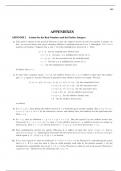Exam (elaborations)
Complete Solution Manual Discrete Mathematics and Its Applications 8th Edition Questions & Answers with rationales (Chapter 1-13)
Discrete Mathematics and Its Applications 8th Edition Solution Manual Complete Solution Manual Discrete Mathematics and Its Applications 8th Edition Questions & Answers with rationales (Chapter 1-13) PDF File All Pages All Chapters Grade A+
[Show more]



